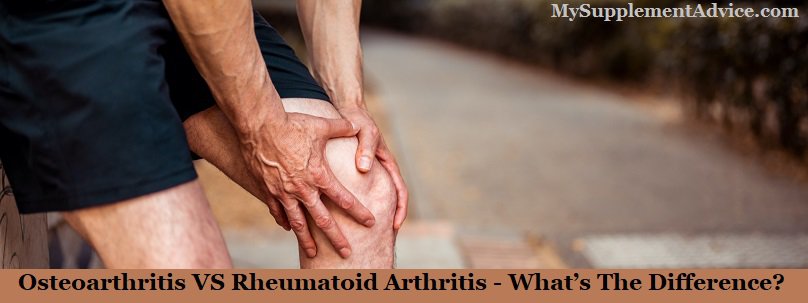
Do you know that there are more types of arthritis?
No?! Well, if this is brand new information – this article is what you need.
Do you want to find out the difference between several types of arthritis?
Well, here's “Osteoarthritis VS Rheumatoid Arthritis”, an article that talks exactly about this.
It will help you differentiate between these two diseases.
Note. This article is based on my own research on osteoarthritis and rheumatoid arthritis.
1. Causes
First of all, let's clarify something.
The word “arthritis” is a general term that describes the inflammation of the joints.
As I said before, there are more types of arthritis.
The most common ones are osteoarthritis and rheumatic arthritis.
So, let's see what causes these two joint problems.
1. Osteoarthritis
Osteoarthritis is the most common form of arthritis.
What causes it?
Well, osteoarthritis is caused by cartilage tears in joints.
In fact, it can appear in almost any joint in the body, but it usually occurs in:
- hips
- knees
- spine
Who is more likely to develop osteoarthritis?
The risk increases with age. [1]
Also, there are other factors that should be taken into consideration:
- obesity
- sex
- heredity
- joint injuries
- joint overuse
- certain diseases
Let's start with the first one, obesity.
Your weight influences the development of several diseases, including OA.
Why is that? Well, there are more reasons for that:
- an increased weight adds stress to your joints, especially those that bear weight (hips, knees)
- fat tissues produce proteins
- these proteins can cause inflammation in your joints
So, what can you do to prevent osteoarthritis?
You guessed it right! You should maintain a healthy weight.
What about sex? How can this influence the development of osteoarthritis?
Actually, women are more prone to osteoarthritis.
Why? There isn't a clear answer to this question as researchers could not discover a certain cause.
What role plays heredity in this story?
Well, heredity can also influence the development of osteoarthritis:
- you might inherit a tendency to develop osteoarthritis
- your cartilage might be more likely to deteriorate
As you find out, people who had joint injuries have a higher risk of developing osteoarthritis.
Here are some types of injuries:
- the ones that occurred when playing a sport
- the ones from an accident
- old injuries that are already healed
So, if you injure your joints you might develop osteoporosis at some point.
Actually, this can also happen if you overuse your joints.
There are certain jobs that require you to constantly use your back or knees.
Well, people who have such jobs are at risk of developing osteoarthritis later on.
Last, but not least, if you suffer from certain diseases you may develop osteoarthritis as well.
Which are those conditions?:
- diabetes
- rheumatoid arthritis
- iron overload
- excess growth hormone
Now that you know what causes osteoarthritis, you can prevent it.
So, let's move on and have a look at the other type of arthritis, rheumatoid arthritis.
2. Rheumatoid Arthritis
Rheumatoid arthritis (RA) is an autoimmune disease.
What does this mean?
Well, basically your immune system attacks the healthy tissues in your joints.
Moreover, other parts of your body might be affected by this condition.
Which are those?:
- lungs
- skin
- heart
- eyes
Which people are more likely to develop rheumatoid arthritis?
Well, there are more factors that should be taken into consideration:
- age
- sex
- family history [2]
- your weight
- smoking
Similar to osteoarthritis, rheumatoid arthritis is more likely to occur in middle-aged people.
Of course, your sex also influences the development of this condition.
So, if you are a woman, you have a higher risk of developing rheumatoid arthritis.
Genetics also influences the development of this condition.
How come?:
- a member of your family suffers from rheumatoid arthritis
- so you might develop it as well
As in the case of osteoarthritis, people who are overweight are at risk of developing RA.
If you are also a smoker, the risk increases even more.
So what can you do to avoid this condition?
You need to stop smoking and maintain a healthy weight, of course.
SUMMARY
Osteoarthritis and rheumatoid arthritis can have common risk factors like age or sex.
However, RA is an autoimmune disease while osteoarthritis is caused by cartilage tears in joints.
Moreover, people who use to smoke have a higher risk to develop RA.
2. Symptoms
Osteoarthritis and rheumatoid arthritis can be similar when it comes to symptoms.
However, there are also differences between those two.
So, let's see what specific symptoms each of them has.
Firstly, we will talk about osteoarthritis.
1. Osteoarthritis
The symptoms of osteoarthritis develop over time, they do not appear instantly.
So, if you suffer from this disease you might experience the following symptoms:
- stiffness
- pain [3]
- joint swelling
- tenderness
- loss of flexibility
As I want to make sure that you understand those clearly, I will give you some more details about them.
Let's start with stiffness.
When does it appear?:
- after you wake up
- after some time of inactivity or rest
What about pain?
Well, pain is a common sign of osteoarthritis.
Usually, your joints hurt during or after movement or activity.
Pain can be accompanied by soreness, another sign which tells you that you might have a problem.
Also, if you suffer from osteoarthritis, you might as well experience swelling.
Why is that?:
- osteoarthritis can cause the inflammation of the soft tissue around the joints
- this can lead to swelling
Beside swelling, your joints might also feel tender when you apply pressure to them.
Moreover, you lose the flexibility of your joints.
So, you might not be able to do all the activities that you want.
Now, let's see what are the symptoms of rheumatoid arthritis.
2. Rheumatoid Arthritis
If the symptoms are milder in osteoarthritis, the ones in rheumatoid arthritis are more severe.
Besides, some symptoms are similar to those in osteoarthritis.
So, if you suffer from RA, you can also experience signs like:
- pain
- stiffness
- tenderness
- swollen joints [4]
I think these are pretty clear, so I won't insist on them anymore.
However, these symptoms can be accompanied by others that are more severe, I should say.
In this category we can include the following:
- fever
- weight loss
- fatigue
- loss of appetite
- weakness
Moreover, RA can affect other parts of the body besides joints.
So, you can also experience some unusual symptoms.
Why unusual? Because normally you wouldn't think that those are related to RA.
To cut to the chase, I will mention some of them:
- hearing problems
- insomnia
- loss of vision
- lung issues
- skin diseases like hives
Thus, you need to pay attention to all these signs if you want to know what problem you have.
SUMMARY
RA and osteoarthritis can have similar symptoms like joint pain, stiffness, and swelling.
Yet, while in the case of OA symptoms are mild, people who suffer from RA have more severe symptoms.
Also, RA doesn't affect only joints, but other parts of the body too.
3. Treatment
First of all, I have to say something to you.
These two conditions cannot be treated. What I mean by that is that you can't get rid of them.
Why do you need treatment then?
Well, that's because it can relieve your symptoms and help you keep your problem under control.
So, let's see what treatment is best for you according to the type of arthritis you suffer from.
1. Osteoarthritis
When it comes to osteoarthritis, there are more treatments that you can try.
Of course, you can see a doctor and receive a prescription.
However, there are more solutions to this problem beside this one, of course.
You can try taking some drugs that can relieve your pain. [5]
Here we can include the following:
- paracetamol
- non-steroidal anti-inflammatory drugs
What are non-steroidal anti-inflammatory drugs or NSAIDs?
They are painkillers that can reduce inflammation and also pain.
Can you get them without a prescription?
Of course! Moreover, they are usually creams, so it is quite easy to use them.
However, you can also take NSAID pills in case paracetamol doesn't help you.
Let me give you some examples:
- ibuprofen
- naproxen sodium
What else can work in your case?
Well, you can also use cartilage rebuilders. These will repair the damaged cartilage.
From those, you can pick glucosamine sulfate + chondroitin, which are some of the best ones.
You can easily find those two substances included in different supplements.
If you want to try some more natural remedies, I can recommend the following for you:
- ginger
- Boswellia
- arnica
- aloe vera
Those herbs will help you reduce your pain and ease your symptoms.
Besides, don't forget that exercising is always helpful.
So, make sure that you spend at least 30 minutes per day doing exercises.
2. Rheumatoid Arthritis
What treatment works best for people who suffer from rheumatoid arthritis?
As in the case of osteoarthritis, the treatment usually helps you reduce inflammation and pain.
So, I can also advise you to try NSAIDs.
I already mentioned what drugs are included in this category, so I won't insist on that anymore.
What else can you do? Well, you can go to a doctor and receive a prescription.
Among others, your doctor might prescribe you steroids.
This treatment can reduce your pain, inflammation, and stiffness.
However, if you want a more natural remedy, you can try turmeric.[6]
Like other herbs, it has many benefits:
- has anti-inflammatory properties
- eases your pain
Actually, turmeric is the very best natural anti-inflammatory, so it definitely deserves a try.
As it is so popular, you can try more products that contain turmeric:
- supplements
- creams
- teas
- detox water
- oils
What else can you try?
Well, you can massage the affected area with a cream or oil that is helpful for you.
Here I can mention the following:
- arnica cream
- ginger oil
- eucalyptus oil
- orange oil
Moreover, you need to exercise regularly and eat healthy foods.
In this way, you will manage to keep RA under control, I'm sure of it.
SUMMARY
Rheumatoid arthritis and osteoarthritis cannot be cured, but the symptoms can be reduced.
The usual treatments used for both of them are painkillers and NSAIDs.
Some more natural remedies are turmeric, ginger, arnica, and eucalyptus oil.
My Final Verdict
Do you want to find out the difference between osteoarthritis and rheumatoid arthritis?
Are you curious about their symptoms and treatment?
In this “Osteoarthritis VS Rheumatoid Arthritis” article, you found out the main differences.
I'm sure that you will find out all the information that you need when it comes to:
- causes
- symptoms
- treatment
So, now you won't have trouble distinguishing between those two, I'm certain.
Moreover, you will also know what treatments work best and what you can do to prevent those.
References:
1. https://pubmed.ncbi.nlm.nih.gov/-27734845/
2. https://pubmed.ncbi.nlm.nih.gov/-20870100/
3. https://pubmed.ncbi.nlm.nih.gov/-29671497/
4. https://pubmed.ncbi.nlm.nih.gov/-30596879/
5. https://pubmed.ncbi.nlm.nih.gov/-24467960/
6. https://pubmed.ncbi.nlm.nih.gov/-33914984/















